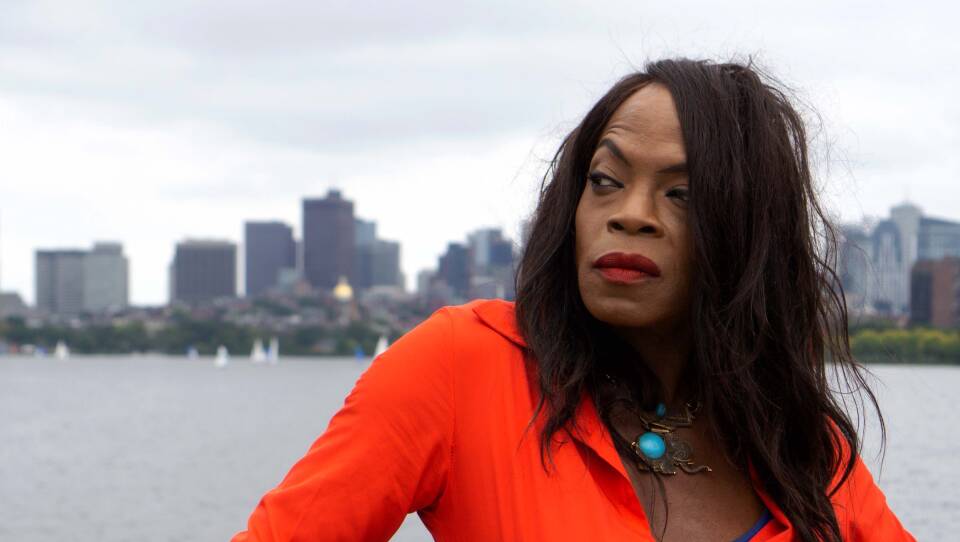Dreya Catozzi started selling her body for cash at age 17.
Born identified as a boy, Catozzi says she always knew she was female. She grew up in an impoverished family, was molested as a child and learned quickly that she had to take care of herself to stay alive.
“I figured out the game at a very young age,” said Catozzi, now 52. “I knew I needed money to pay rent. I knew I needed money to eat. It was just to survive.”
It is not an uncommon story for trans youth.
In Massachusetts and across the United States, trans females are disproportionately at high risk of sex trafficking and exploitation for a host of reasons connected to discrimination, family rejection and failures of government systems to intervene on their behalf. Many end up in the state child welfare system, where they can be mistreated, misidentified and ultimately homeless — putting them at greater risk for abuse.
In our series UNSEEN: The Boy Victims of the Sex Trade, the GBH News Center for Investigative Reporting has revealed growing evidence that, in New England and across the United States, there are likely thousands of male victims of commercial sexual exploitation and trafficking, far more than previously understood. It is also clear from our reporting that trans female youth, who were identified as male at birth, face the highest risk of becoming victims of the sex trade.
More National News
“From the [trans] people that I know personally, most of them have engaged in sex work, survival sex work, at some point in their life,” said Tre’Andre Valentine, executive director of the Massachusetts Transgender Political Coalition , a statewide advocacy organization run by trans people. “It’s not something that is uncommon in our communities.”
Data in Massachusetts and across the United States is lacking, but growing documentation shows a disproportionate number of vulnerable trans female youth are exploited, trafficked, abused and even murdered.
A 2015 survey by the National Center for Transgender Equality found that one in five trans women said they had engaged in sex work.
“They are the marginalized community within the marginalized community,” said Shaplaie Brooks, director of BUILD — Being United In Leading our Destiny — the state’s only nonprofit program focused on working with sexually exploited and at-risk boys, trans female and gender-fluid youth.
“If you want to change the system for anyone, you need to look at the most depressed person in the room,” Brooks added. “And that’s the Black trans woman.”
I knew I needed money to pay rent. I knew I needed money to eat. It was just to survive."DREYA CATOZZI
Most of the young people BUILD has recently worked with are trans, mostly trans girls. Many are former foster care youth who advocates say are the most likely to be sexually exploited, including being trafficked and sold for sex to survive.
Transgender and gender non-conforming youth experience higher rates of violence and sexual abuse than youth who are cisgender — those who identify with the gender they were assigned at birth — according to the Boston-based Judge Baker Children’s Center . Its 2021 study found that about a quarter of transgender students in Massachusetts, mainly girls, report having been raped or abused while dating. They were also more likely than non-trans students to report sexual intercourse before the age of 13, the report found.
There are roughly 6,000 trans and gender non-conforming high schoolers in Massachusetts , or about 2% of the state’s nearly 290,000 students.
Christopher Bellonci, chief medical officer of the Baker Center, says trans youth need to be provided resources to live as well as affirmation of who they are.
“If you don’t feel good about yourself, and we don’t address that despair and that underlying poor self-esteem that we hypothesize is a direct result of rejection for your sexual or gender identity, then these young people are going to continue to make poor choices,” Bellonci said. “I don’t feel like many of these young people feel like they have a choice when they end up in these situations where they are being sexually exploited.”

Chastity Bowick confirms Bellonci’s assessment.
“I’ve been beaten, I've been abused, I’ve been molested,” she said. Bowick is executive director of the nonprofit Transgender Emergency Fund of Massachusetts that provides resources to trans people in need. “When you’re kicked out of your house between the ages, usually 13 to 17, you miss a lot of critical life lessons,’’ she said.
And homelessness is often a precursor to sexual exploitation, as desperate young people seek ways to make money and care for themselves. “I was not really much of a streetwalker,” Bowick said. But, she said, “I did have my nights where I was there in the streets.”
The foster care trapdoor
For many Massachusetts trans youth, the path to sexual exploitation runs through the foster care system.
Brooks said that large numbers of transgender youth run away from foster homes because of alienation, and the failure by foster parents and social workers to affirm their gender. This sets the stage for them to be preyed upon by sex traffickers who “groom” young transgender females. “Many of our youth go AWOL for months at a time,” she said, falling into abusive relationships. “Unfortunately, they’re placed in a situation where they’re being exploited.”
A scathing report released in July by the Massachusetts Commission on LGBTQ Youth supports Brooks’ claims. The commission alleges that the state Department of Children and Families has failed to protect LGBTQ youth under its care from sex traffickers, pimps and men seeking sexual favors in exchange for housing and other non-monetary support.
Hannah Hussey, the report’s author, said transgender young people of color in foster care are particularly “underserved” by DCF — either placed in non-affirming homes or not tracked if they run away. “The result of that is things like homelessness. It’s things like maladaptive or unhealthy coping strategies,” she said. “It’s a higher risk of exposure to violence or exploitation.”
And this problem is not new. In the 1990s, Gov. William Weld created the Governor’s Commission on Gay and Lesbian Youth, which revealed a “pipeline” of LGBTQ youth who aged out of foster care and ended up homeless. Many sold their bodies to survive, the commission’s 1994 report found.
“What we see two or three decades later is that the same pattern continues to occur,” said Hussey. “Far too little has changed.”
Patience Crozier, a senior attorney for GLBTQ Legal Advocates & Defenders in Cambridge, says she is deeply disappointed with DCF for failing to respond to the needs of LGBTQ children. Especially, “transgender girls of color, [who] face so much pervasive bias, discrimination, violence,” she said. “I think over the course of my work, I have really in many ways changed my view of Massachusetts as a progressive state.”
Crozier says a major obstacle to ascertaining the depth of commercial sexual exploitation of young transgender females is the state’s failure to identify them. According to the July report, “state-specific data on DCF-involved LGBTQ youth are largely unavailable — a problem in and of itself.”
GBH News requested an interview with Massachusetts’ DCF but received only a written statement. The department said it had launched this spring “trainings for social workers focused specifically on sex trafficking of high-risk children, including transgender and youth who identify as LGBTQ and gender non-conforming.”
Among other steps, DCF said that it had accelerated recruitment of LGBTQ foster parents and is enforcing a policy that affirms gender identity by asking a child how they want to be identified.
This step was among a series of recommendations made to DCF by Roxbury Youthworks and the anti-trafficking organization My Life My Choice, to discourage kids from running away. The two nonprofits were brought on board to train DCF staff and foster parents to respond to the needs of kids who have been commercially sexually exploited.
Over the course of my work, I have really in many ways changed my view of Massachusetts as a progressive state.PATIENCE CROZIER
Executive director of My Life My Choice, Lisa Goldblatt Grace, says finding appropriate homes for transgender kids is a major challenge because of systemic flaws and resistance from children’s families. She described the case of a trans female youth she referred to as “Jamie” whose grandmother wasn’t supporting the fact her grandchild identified as a girl. At her grandmother’s insistence she was placed initially in a program for boys. “You can imagine the kind of challenges that Jamie faced in this boys’ program when she was very much identifying as a girl,” said Goldblatt Grace.
It’s a national problem. Transgender youth, especially trans female youth of color, are more likely than heterosexual youth to run away from home and foster care, federal studies show.
A 2021 study by the Trevor Project, a national organization providing crisis intervention services for LGBTQ young people, found that an extraordinary 40% of transgender and non-binary youth in foster care reported running away, being kicked out or abandoned compared to 17% of cisgender LGBTQ youth in foster care.
And transgender female youth of color, in particular, who are pushed or pulled from foster homes, frequently live under conditions that thrust them disproportionately into the sex industry.
A 2020 Office of Planning, Research and Evaluation report linking foster care and human trafficking found that lopsided numbers of transgender female foster youth 17 and younger sold their bodies in exchange for money, goods or a roof over their heads. By law, such transactions involving juveniles are classified as human trafficking.
Affirming a trans girl’s gender identity and instilling confidence at an early age, experts say, is key to keeping them safe.
The nonprofit Annie E. Casey Foundation recommends that courts take a more active role to guarantee state compliance. The foundation, which advocates on behalf of children, said courts should enforce a 2014 federal law — the Preventing Sex Trafficking and Strengthening Families Act — that instructs state child welfare agencies to protect children from sex trafficking, create plans to locate and respond to children who have run away from foster care and report known sex trafficking to law enforcement.
Hussey says it’s imperative that Massachusetts officials act quickly — citing high suicide numbers among transgender youth in foster care, among other issues. “It’s not an exaggeration to say that this is a matter of doing life-saving work,” she said.
‘Just made for sex’
Sitting poised in a Boston radio studio wearing a fashionable sleeveless orange dress and silver necklace, Dreya Catozzi appears to be fiercely confident. But, she said, she was not always so self-assured. She was one of six children growing up in Denver in a household where drug use was not uncommon. Catozzi was sent away at one point to live with her sister in Texas and says she was sexually exploited by her sister’s husband when she was about nine years old. The experience left her vulnerable to other predators.
“When I told my mother I was sexually abused, no one took action, I never felt like I had a safe place,” she said. “I used to say I was, like, born with a neon sign on my back, ‘just made for sex,’ because that’s all I knew.”
Catozzi says she descended into sex work and spent years earning a living in pornographic films and visiting clients at private residences.

Some of it, she says, was a cry for help. But no one protected her.
“My mother did not protect me,” Catozzi said. “I love my mom. May her soul rest in peace and please, please, don't judge by what I'm getting ready to say. When I reached out to her, I told her, ‘I’m doing sex work. I want help.’ And she said to me, ‘If you’re doing sex work, why haven’t you given me any money?’”
Catozzi says it was the prospect of going to prison that ultimately made her quit.
“I took a bad call one night and I took this call against all of my instincts. I was in the client’s room,” she recalled. “The door got kicked open and I was like, ‘Is this a hate crime or am I being arrested?’ When I saw the badges and all the guns drawn, I knew I had walked into a raid.”
Catozzi survived. Many others haven’t. The nonprofit Human Rights Campaign released a report in 2018 finding 128 transgender and gender non-conforming people were killed over a six-year period — at least a third of them were engaged in sex work.
Various local and national non-profits operate as counter-weights to high-risk sex work and exploitation of trans female youth, including, in Massachusetts, the Home for Little Wanderers, My Life My Choice and Roxbury Youthworks’s BUILD.
But advocates say more needs to be done. Catozzi, who did not go to college, said she held down many fast food jobs over the years beginning as a teenager in Denver. But sex work was the only one that allowed her to pay the bills.
“I dropped out of school very early and I was able to hop from job to job,’’ she said. “But I always had sex work as a side.”
I used to say I was, like, born with a neon sign on my back, 'just made for sex,' because that's all I knew.DREYA CATOZZI
Catozzi said wider acceptance of transgender females in grade school and in every aspect of American life at an early age would open career paths and counter the marginalization that pushes many into homelessness and sexual exploitation.
Many in the trans community say they have no other choice but to band together to protect themselves, especially the youngest among them.
As a child growing up in Rochester, New York, Bowick remembers the perplexed looks on the faces of family members and the questions directed to her mother about her youngest child.
“I knew I was different when I was little, I was more on the feminine side, but my mother used to just tell my family like, ‘Oh, he’ll grow out of it,’” she said. “But I knew it was something more. And as I got older, preteen, I started to realize that I am not the person that’s supposed to be in this body.”
Bowick said after running away to Boston she looked for a trans support community and found none. So, she created one. Today, Bowick’s Transgender Emergency Fund supports low-income trans youth facing the prospect of nights without shelter, as she once experienced. She wants to help save lives.
“Sometimes when you leave your house in the morning, you don’t know if you’re going to make it home that night,” she said. “That’s a reality.”











